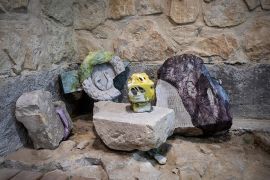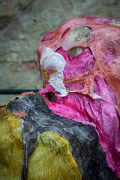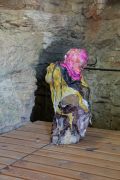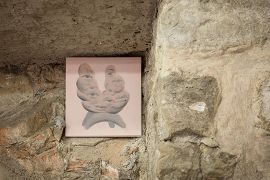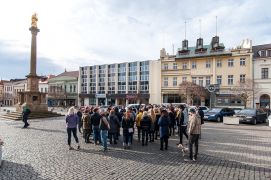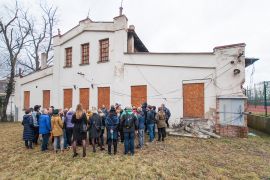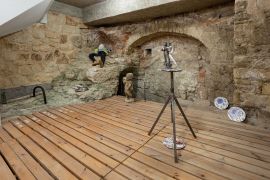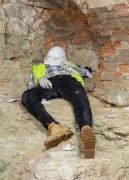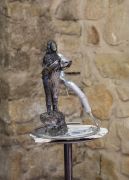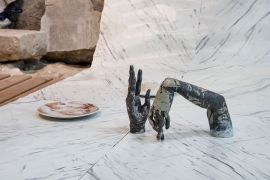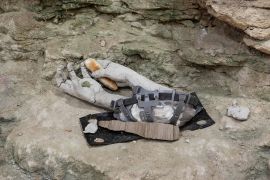The St. Havel Gallery in Mladá Boleslav had its first exhibition in 2017 as part of the Noc Kostelů (Night of Churches). The initial impulse came from the availability of an unused cultural space which would be independent from the city. The motivation was to introduce a distinct alternative to the operation of the city’s cultural centers. This interview took place on 28 January, 2020 with Jonatan Hudec, Martin Herold and Jiří Dalecký who run the St. Havel Gallery.
Agosto Foundation (AF): How did the St. Havel gallery get started?
Jiří Dalecký: We met with Jonatan, who is an Evangelical priest and who takes care of the buildings and the whole space of Havelský park, and he showed us an unused space just under the caretaker’s house, near the St. Havel church. He gave it to us for use, as he wanted to bring some life into the space. We pooled our forces with Martin, who is a graduate of the Academy of Fine Arts, and organized an exhibition of his work. That was the first exhibition. Both me and Martin were born in Mladá Boleslav, and although we both live in Prague now, we were always missing something back home, and it was exactly such a space.
AF: I read somewhere that it was originally supposed to be the City Gallery of Mladá Boleslav.
Martin Herold: When the Havelský park was being renovated in 2003, the space was apparently conceived as a city gallery. There was one exhibition there in the past, but it then started to be used as a storage space.
Jiří Dalecký: Almost no one from the residents of Boleslav knows about it, although it is a very interesting place. Not only the space itself, but also its location in the surrounding park.
Martin Herold: Jonatan was inclined to have us continue in organizing events there. We had an idea as to what type of program we could bring there: exhibitions of contemporary art, works of professional artists and graduates of artistic academies which we were missing in the city. The city galleries mostly feature works by local artists and hobby artists, and they lack a deeper sense of dramaturgy. The same year, which we considered to be a pilot year for us, we organized a number of other exhibitions there too. From spring of 2018, we had a program which featured five exhibitions per season. The program runs from spring until autumn. The gallery is in a park, there is even a verandah, and when we have events there, people can spend time in a truly pleasant space.
AF: Jonatan, what led you to offer the space up for activities such as these? I find it interesting that here, contemporary art meets the Evangelical church, which isn’t usual. Church institutions often have a very conservative approach to contemporary art.
Jonatan Hudec: I wanted to rejuvenate it somehow. The space itself begged for it. I don’t really know what led me to it. Perhaps a force from above, as it was truly a happy accident. I consider everything that comes to me as an opportunity which should be tested. If it works out, or if I see it bearing fruit, one must develop it further. That is also why we asked the Agosto Foundation for the PERPEDES grant, so that we could continue in such works. Contemporary art, or the art of Martin’s generation, speaks to me and I enjoy it, as it is something different, something new. And it is also a type of pathfinding in the contemporary world, a reflection on its realities. The exhibitions have wide import and a good goal in mind. For example, Juliana Höschlová with her “age of plastic”, or that one performance which reflected on attention deficit disorders.
Martin Herold: We try to select authors who relate their work to some current problem. We are also interested in the relationship to the space and its context, or to the city. That is our key to selecting exhibitions.
Jonatan Hudec: I think this is in line not so much with the spiritual emphasis of the Church, but rather with that of Christian engagement, which is part and parcel of that. I think that the social content of the young artists’ exhibitions resonates and is in harmony with my own affinities, as much as those of the Church. I think that this can open new spaces for those groups who are interested in art, but also for the community which I tend. Art speaks of similar things by means other than ‘the word’, which I employ in my position as priest.
Martin Herold: We try to keep in mind the context in which our exhibitions appear. We try to find balance between the mostly closed world of contemporary art and a higher accessibility for unprepared audiences. But we want to avoid frivolity and the organization of cheap, decorative exhibitions.
AF: What is the gallery’s future, and how sustainable is the project?
Martin Herold: We are struggling with some things related to urbanism and with how the city is shaping up. The gallery is in a historical part of town, in the very center, which is often quite empty and nothing is really happening there. We understand the problem with the historical monuments and public space and we want to focus more on it this coming year. The first exhibition should be that of sculptor Matouš Lipus who focuses on art in the public space and should expand out of the gallery. And then there are the other activities, like our collaboration with the association Prázdné domy (Empty houses).
Jiří Dalecký: This association maps empty, unused houses and also organizes city tours. It had only been in Prague at the time, and we arranged for the first event outside of the capital. The first tour through Mladá Boleslav turned out great – some fifty people came – and we would like to continue in that. We want to show people that it is possible to walk through the city and think about the spaces you are walking through – that a house which you might be passing every day on your way to and from work or school has some quality of its own; to be conscious of how it looks, what happens inside it. It would be ideal if other people became interested in the tours and would also start following our gallery. We also want to organize meetings where we invite a guest to speak on topics such as urbanism, art in the public space or art history.
Martin Herold: We would also like to be active outside the gallery, but to focus on topics which relate to it. For example, to connect such events with the exhibitions as a type of accompanying program. This year, we thought of doing this, but next year, we might think of something new again.
AF: Are you negotiating, or do you plan to negotiate, with the city for support?
Jiří Dalecký: Last season we received a grant from the Central Bohemian region. But we don’t want to ask the city for support. We are aware that if we want to change something, we must be critical towards the municipality and we would then be limited in our freedom of expression, either directly or indirectly. At the same time, we don’t want to be a priori critical towards the municipality – for the abovementioned tour, it opened one empty house for us, the Grandhotel Věnec at Staroměstské square, which is now in their possession. It was interesting for everyone to hear about its glorious era, which was about one hundred years ago, the visit of T. G. Masaryk, and then to see its current state. So we are in contact with the municipality, but rather we prefer to be independent of them.
AF: We talked about the fact that you two live in Prague. Martin, you are a member of the Studio Prám?
Martin Herold: Studio Prám is an association, and we have studios there, and a residency and exhibition program. The exhibitions which take place at the GSH are similar in some ways to those in Prám: we are a smaller, independent gallery and we often give space to recent graduates of art schools. At the moment, both me and Jiří are mostly in Prague, but we very much care about Mladá Boleslav. That is why we appreciate that Jonatan had initiative and supports us.
Jonatan Hudec: I nowadays mostly think of the gallery’s sustainability. I am a bit afraid that most of it is up to me. In four years, my elected period will come to an end in Boleslav, and I might change my placement. The guys are young and they can continue. It is definitely necessary to think more of the future. It might be good to find some engaged person right here in Boleslav. Someone who goes to exhibitions and is interested in the space and maybe attempt to make it into an independent space which would have a life of its own. But these are just my ideas which may come to pass or not.
Jiří Dalecký: The gallery really stands on the initiative of Jonatan. We do it because of our interest in the city, but Jonatan is there physically. We are also friends on a certain level, so we can do this all voluntarily. I think that it is mostly about the topics – it doesn’t have to be the Gallery of St. Havel, but we want our activities to resonate among people, and maybe someone can pick up on that in a different format. I would be happy if it turned out this way.
AF: Do I understand it correctly that you are trying to initiate something also outside of the framework of the gallery itself?
Jiří Dalecký: Yes, I think a similar debate is sadly lacking in this city. But there might be some parallel group which might feel the same way, but we just don’t know about one another. I think that if we managed to start up something, it would take a course of its own.
Jonatan Hudec: I expect that it will come, because the space is also operated by the caretaker Marek Havlas who also has a café there, organizes film screenings and is trying at the same thing, just by different means. We share the spaces and partly also the community. The unique input of Jiří and Martin is the contact with contemporary art. Nothing much is happening in Boleslav, but it’s not so far from Prague that we couldn’t make use of its culture. It is important for young artists to have a place where they can exhibit.
Martin Herold: Thanks to Jonatan, the exhibiting artists can stay at the vicarage during their preparation of the exhibition. The environment is very pleasant and inspiring for the authors.
Jonatan Hudec: Yes, they come and put together an exhibition, and spend some time at the vicarage. Event his overlap and everyday communication is beneficial for both sides. I think it is well set up. I considered extending the activities also to residencies, but we lack the means right now.
AF: It occurs to me in this regard that if something is happening in the regions, away from the big cultural centers, it is important whether the wider community accepts it. If it doesn’t find acceptance, the activities oftentimes cease. What have the reactions from the wider community been so far?
Jiří Dalecký: At first, it was mostly friends who came, but after a while a certain community formed. It is a social event and this gradually draws more people. But Mladá Boleslav is rather placid, so it doesn’t really resonate so widely in the city. We try to make small steps and get more acknowledgement among the public. We do this in our spare time and we lack the means to better advertise. It is a long process.
Jonatan Hudec: Most people in Boleslav live, simply put, a hectic, empty and consumerist lifestyle. They search for popular culture to blow off steam, or attend the beer fest at Psí Louka. What we do here grows elsewhere and is intended for a different type of person, but one who also lives in the same city. I am convinced that the future of our country and the cultivation of society on the basis of values has always been a project of smaller groups who look further into the future and try to change something in society, which largely staggers into its future without looking ahead. In this context, working for a smaller community makes a lot of sense. It is also possible to change or channel the direction of our society which otherwise, at least I think, is becoming empty on the inside as well as complacent to its outside.
AF: And the reactions among artistic circles? Are you trying to keep a certain level of quality in your exhibitions and do you invite professional artists here?
Martin Herold: The reactions are proportional to it being a small, up-and-coming gallery which we run in our spare time. But we have been receiving positive reactions, sometimes unexpectedly so. Sometimes we are followed by quite unexpected people. Our generation often follows art on social networks, and it stops being important where the exhibition is actually taking place. Yes, we get positive feedback, but it’s not overwhelming. We have about three to five exhibitions a year.
AF: Do you want the expert critics to take notice, or is this not an issue for you?
Martin Herold: It might be the next step. We would like to speak more to the expert public.
Jiří Dalecký: We could ask for public grants, but even the aforementioned grant from the Central Bohemian carried with it a lot of administration and responsibilities for Jonatan. The Agosto Foundation grant grave us much more freedom and a wider perspective insofar as we can split the resources across a few seasons. For us, it is certainly better to last as long as we can with a smaller budget and retain our freedom and independence.
The interview was conducted by Radoslava Schmelzová.


